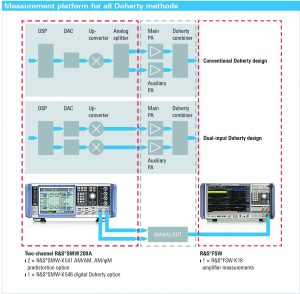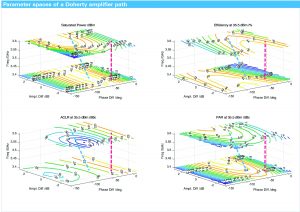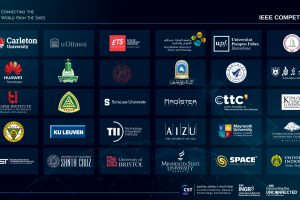
Figure 1: The vector signal generator produces the path signals for Doherty amplifier designs and the signal and spectrum analyser provides data for design optimisation
Doherty amplifiers, especially those with two independently driven inputs, promise significantly better energy efficiency in 5G basestation transmitters and similar applications. Power amplifiers in basestations constitute 30‑60% of the cost and 20‑60% of the energy consumption of the transmitter infrastructure, so optimal design is a focus for RF power semiconductor and infrastructure vendors.
The most effective ways to reduce amplifier power dissipation have been known for a long time, but energy-efficient operation comes at the cost of non linearities that have to be compensated by upstream or downstream measures. These are non-trivial measures such as digital predistortion that are only possible with advanced circuit technology.
Doherty operation
For infrastructure, conventional Doherty power amplifier designs are established, whereas envelope tracking dominates on the device side.
In envelope tracking, the supply voltage of the power transistors is dynamically adapted to the signal envelope. The Doherty method splits the input signal into two parallel amplifier paths. The main amplifier handles the base load and is permanently operated at energy-efficient, full modulation. If the input signal rises above a certain level, the second amplifier switches on and handles only the load peaks.
This task sharing is particularly promising for digital signals, characterised by a high crest factor. It will take years to migrate it to high millimeterwave frequencies and wideband applications such as 5G and satellite communications (satcom).
Perfect Doherty operation is a theoretical concept that cannot be achieved in practice. Nevertheless, even with rough approximations, performance is usually better than the baseline class AB amplifier at low operating frequencies and small bandwidths.
The technique becomes less tolerant to rough approximations and hence less efficient as operating frequency, bandwidth and output power increase. New and repeatable design processes are required to harness its full potential.
A new software option for the Rohde & Schwarz SMW200A vector signal generator (Figure 1) helps designers realise the full potential of their amplifier designs. It is designed for use with the FSW signal and spectrum analyser.
Split design approach
Doherty designers have to design two halves, the input side and the output side.
The signal to be amplified must be split in order to drive the two amplifier paths. There are different approaches to achieving this. Classic implementations perform the split in the analogue domain and dual-input solutions perform it in the digital domain (Figure 1).
Studies published in peer review literature suggest that dual-input split implementations could realise up to 60% more RF output power and 20% more energy efficiency over a 50% wider bandwidth than a classic Doherty implementation. The challenges remain the same whether the amplifier is being developed for 5G and satcom transmitters or for other applications that require high performance and reproducibility.
Designers want to ensure maximum performance from the design under the expected operating conditions as efficiently as possible. Unfortunately, these are mutually contradictory goals, and one can only be achieved at the expense of the other. It is necessary to find an operating point and a parameter set that minimise these costs, so the sensitivity of the design to frequency, phase and level variations in the amplifiers paths must be known. Current development processes rely heavily on reference designs and manual fine‑tuning of prototypes, which makes it difficult to explore beyond a few local optima.
Due to a lack of insight into the sensitivities of the chosen design, the designer typically specifies conservative metrics to accommodate part-to-part variations in a production environment. The result is usually sub-optimal because the true potential of the design is not fully explored and specified.
Doherty amplifier development

Figure 2: The dashed red line shows a possible sub-optimal operating point, suggesting operating parameters (the blue dotted line) (visualisation using MatLab)
Only by stimulating the two amplifier inputs with a range of different signals is it possible to identify and understand the performance trade-offs and sensitivities (Figure 2). Dual-input Doherty amplifier designs, in particular, benefit from this approach, as well as classic designs such as fixed RF input splitter, programmable RF input splitter and dispersive input splitter ones.
A key requirement for this measurement‑based development process is a vector signal source that can produce two precisely aligned signals, such as the dual-path SMW200A, which can generate signals whose relative phase, timing, amplitude and absolute input power can be finely and reproducibly adjusted.
 Electronics Weekly Electronics Design & Components Tech News
Electronics Weekly Electronics Design & Components Tech News




For the readers: I know Patrick and Gareth well, as we’re colleagues at Rohde & Schwarz. They are on the cutting edge and helped with the launch of the Rohde & Schwarz inaugural RF Lumination event at the Biltmore in San Jose recently. It dealt in great detail with Doherty amplifiers specifically and 5G in general. It was deep and engaging. I know, ’cause I was there and saw first hand how a room of designers can be so engaged as to almost miss lunch! But seriously, it was a great event. If you’re interested in RF at all, you have to check out the papers: http://bit.ly/2I6p85S
Nice article, guys.
I know Patrick and Gareth well! Nice article guys! The whole topic of Doherty amplifiers was a key part of our (Rohde & Schwarz) inaugural RF Lumination event at the Biltmore in Silicon Valley a few weeks ago. It led with 5G, of course, but it really had the best of Rohde & Schwarz’s RF talent and Gareth’s team did a great job. The audience didn’t leave even after last call for food! If you’re interested in RF, you should check out the papers here: http://bit.ly/2I6p85S